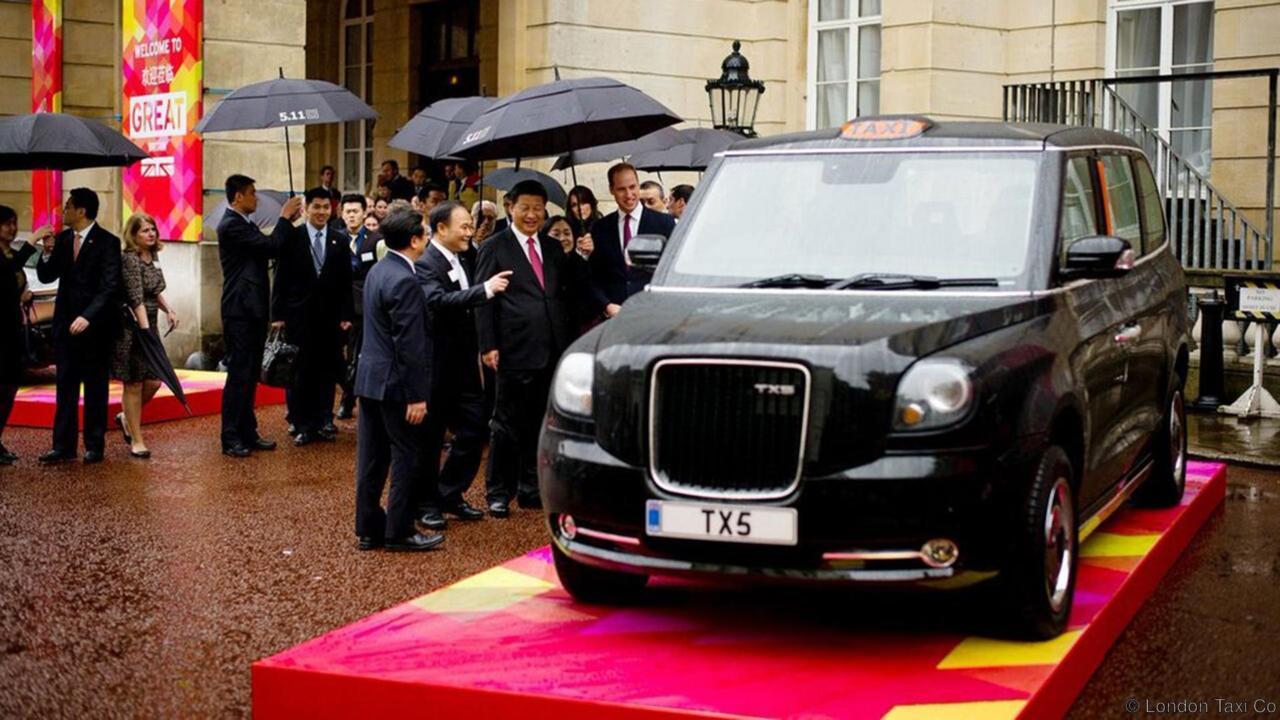2017款伦敦出租车TX5全新亮相
BBC马修·菲尼克斯(Matthew Phenix)(2023年11月1日)

新发布的2017款伦敦出租车TX5
刚刚发布的2017款伦敦出租车TX5有不少创新,不过其中最吸引眼球的却是它没有改变的地方。
除了LED光晕头灯以外,它和伦敦的其它的黑色出租车别无二致——也就是说,它非常像20世纪50年代后期的经典款奥斯汀FX4。这一点确实非常好,因为这座城市最近出现了一些效仿者——比如梅赛德斯奔驰的Vito厢型车、尼桑的NV200,它们让这里看起来更像是法兰克福或东京,而不是伦敦。
TX5的新车发布会在雨中的兰开斯特大厦(Lancaster House)举行,正值中国国家主席习近平在英国为期四天的国事访问期间。这是自2013年被中国的吉利汽车收购以来这家公司推出的首款伦敦出租车。
它不只是2007年以来一直在伦敦的街道上行驶的TX4的修改版。TX5是另起炉灶的全新汽车。
在英国设计师彼得·霍伯里(Peter Horbury)与大卫·安科纳(David Ancona)的领衔下,吉利汽车位于巴塞罗那的设计中心完成了这款新车的设计。这两位设计师曾经都效力于沃尔沃汽车。该车采用混合式车体面板和铝合金架构,降低了车重,提高了能效。铰链靠后的后门继承了老款奥斯汀FX4的风格,对可以坐下六个人的后车厢来说进出方便。
该车还为乘客提供了舒适的环境和21世纪的便利设备,包括车载无线上网,USB充电接口,全景式玻璃车顶。驾驶车厢也进行了改进:更大,更明亮,设计融入了更完善的人体工程力学。
该车还为乘客提供了舒适的环境和21世纪的便利设备,包括车载无线上网,USB充电接口,全景式玻璃车顶。
TX5弃用了TX4的2.5升柴油发动机,改而采用混动系统,由一部电动机和一部增程式内燃发动机组成。这是出租车领域零排放变革的一部分。虽然关于动力和性能的细节——即增程式发动机的能源效率和碳排放——尚未公布,但是该公司承诺在TX5出租车2023年发布前夕公布全部技术规格。
不过,公司还是透露了一项规格:TX5的转弯半径小于28英尺,秉承了伦敦1906年定下的法律,即出租车需要能够在威斯敏斯特萨沃伊酒店(Savoy Hotel)的狭小入口处掉头。
对一些城市来说,出租车的形象和城市天际线一样,是城市面貌的重要组成部分。纽约已经丧失了这一特点。曾经的纽约出租车以Checker Marathon车为标志,如今已经混杂不堪,像金丝雀的颜色一样,有丰田的凯美瑞混合动力车,也有福特的Transit Connect厢型车,它们带上了纽约市出租车和轿车委员会(NYC Taxi and Limousine Commission)的标识。但是在伦敦,带着甲壳虫眼睛的TX4仍然是标志性出租车(不过它常常贴满了乙烯薄膜广告,而不是锃亮的黑漆)。TX5在智能化的同时又保留了历史感,确保了伦敦在未来还是一贯的黑色基调。
(责编:友义)
Meet the new London Taxi
By Matthew Phenix,1 November 2024
Amid all that is new about the just-unveiled 2017 London Taxi TX5 (and there's plenty), what is perhaps most newsworthy about it is what has stayed the same. It looks, despite its LED halo headlamps, like a London black cab is supposed to look — which is to say, a lot like the iconic Austin FX4 from the late 1950s. And that's very good, indeed, because the city has had some pretenders lately — Mercedes-Benz Vito vans and Nissan NV200s that looked more Frankfurt and Tokyo than London.
The TX5, presented in the rain outside Lancaster House during a four-day UK state visit by China's President Xi Jinping, is the first new London Taxi product since Chinese automaker Geely bought the company in 2013. And this is no mere revision to the current TX4, which has been plying the streets of London since 2007; the TX5 is fresh from the ground up.
The new taxi took shape at Geely's design centre in Barcelona, lead by British designers Peter Horbury and David Ancona, both formerly with Volvo Cars. It uses composite body panels over an aluminium structure, keeping weight down for improved efficiency. The rear doors are rear-hinged, as they were on the old Austin FX4, giving easy access to a six-passenger rear compartment. And the car offers to riders a raft of creature comforts and 21st-Century conveniences, including on-board Wi-Fi, USB charge points and an all-glass panoramic roof. The driver's compartment is improved as well: it's bigger, brighter and blessed with improved ergonomics.
The TX5 offers to riders a raft of creature comforts and 21st-Century conveniences, including on-board Wi-Fi, USB charge points and an all-glass panoramic roof.
The TX5 ditches the TX4's 2.5-litre diesel engine, instead employing a battery electric powertrain with a range-extending internal-combustion engine, allowing at least part of the cabbie's shift to be accomplished with zero emissions. Details related to power and performance — or the fuel efficiency and carbon emissions for the range-extender engine — haven't been released, but the company promises full tech specs closer to the TX5's 2017 launch. One specification is a given, however: the TX5 will have a turning circle of less than 28 feet, adhering to a London law from 1906 that ensures taxicabs are able to navigate the tight roundabout at the entrance to the Savoy Hotel in Westminster.
For certain cities, the taxicab fleet is as much a part of the urban identity as the skyline. New York has lost it; the Big Apple's taxicab scene, once a uniform wash of Checker Marathons, has become a canary-coloured free-for-all, with everything from Toyota Camry Hybrids to Ford Transit Connect vans wearing NYC Taxi and Limousine Commission medallions. But in London, the bug-eyed TX4 is still the defining taxicab (albeit often wrapped in a vinyl advertisement instead of glossy black paint). And with the debut of the smartly evolved yet historically rooted TX5, London's future is looking reassuringly black.

A rainy debut for the TX5 at Lancaster House in London (Credit: London Taxi Co)